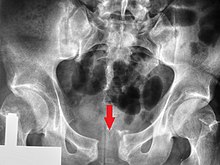
Back كسر الحوض Arabic Fractura de pelvis Catalan Beckenfraktur German Fractura de pelvis Spanish Fracture du bassin French שבר באגן HE 骨盤骨折 Japanese ପେଲଭିକ ଫ୍ରାକଚର OR Fratura da bacia Portuguese Bäckenfraktur Swedish
| Pelvic fracture | |
|---|---|
 | |
| A pelvic X-ray showing an open book fracture | |
| Symptoms | Pelvic pain, particularly with movement[1] |
| Complications | Internal bleeding, bladder injury, vaginal trauma[2][3] |
| Types | Stable, unstable[1] |
| Causes | Falls, motor vehicle collisions, vehicle hitting a pedestrian, crush injury[2] |
| Risk factors | Osteoporosis[1] |
| Diagnostic method | Based on symptoms, confirmed by X-rays or CT scan[1] |
| Differential diagnosis | Femur fracture, vertebral fracture, low back pain[4] |
| Treatment | Bleeding control (pelvic binder, angiographic embolization, preperitoneal packing), fluid replacement[2] |
| Medication | Pain medication[1] |
| Prognosis | Stable: Good[1] Unstable: Risk of death ~15%[2] |
| Frequency | 3% of adult fractures[1] |
A pelvic fracture is a break of the bony structure of the pelvis.[1] This includes any break of the sacrum, hip bones (ischium, pubis, ilium), or tailbone.[1] Symptoms include pain, particularly with movement.[1] Complications may include internal bleeding, injury to the bladder, or vaginal trauma.[2][3]
Common causes include falls, motor vehicle collisions, a vehicle hitting a pedestrian, or a direct crush injury.[2] In younger people significant trauma is typically required while in older people less significant trauma can result in a fracture.[1] They are divided into two types: stable and unstable.[1] Unstable fractures are further divided into anterior posterior compression, lateral compression, vertical shear, and combined mechanism fractures.[2][1] Diagnosis is suspected based on symptoms and examination with confirmation by X-rays or CT scan.[1] If a person is fully awake and has no pain of the pelvis medical imaging is not needed.[2]
Emergency treatment generally follows advanced trauma life support.[2] This begins with efforts to stop bleeding and replace fluids.[2] Bleeding control may be achieved by using a pelvic binder or bed-sheet to support the pelvis.[2] Other efforts may include angiographic embolization or preperitoneal packing.[2] After stabilization, the pelvis may require surgical reconstruction.[2]
Pelvic fractures make up around 3% of adult fractures.[1] Stable fractures generally have a good outcome.[1] The risk of death with an unstable fracture is about 15%, while those who also have low blood pressure have a risk of death approaching 50%.[2][4] Unstable fractures are often associated with injuries to other parts of the body.[3]
- ^ a b c d e f g h i j k l m n o p "Pelvic Fractures". OrthoInfo - AAOS. February 2016. Retrieved 17 May 2018.
- ^ a b c d e f g h i j k l m n ATLS - Advanced Trauma Life Support - Student Course Manual (10 ed.). American College of Surgeons. 2018. pp. 89, 96–97. ISBN 9780996826235.
- ^ a b c Peitzman, Andrew B.; Rhodes, Michael; Schwab, C. William (2008). The Trauma Manual: Trauma and Acute Care Surgery. Lippincott Williams & Wilkins. p. 322. ISBN 9780781762755.
- ^ a b Walls, Ron; Hockberger, Robert; Gausche-Hill, Marianne (2017). Rosen's Emergency Medicine - Concepts and Clinical Practice E-Book. Elsevier Health Sciences. pp. 577, 588. ISBN 9780323390163.